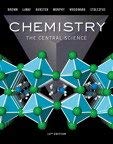
Test Prep Series for AP Chemistry for Chemistry: The Central Science 14th ed AP
14th Edition
ISBN: 9780134661483
Author: Edward L Waterman
Publisher: PEARSON
expand_more
expand_more
format_list_bulleted
Question
Chapter 21, Problem 84AE
(a)
Interpretation Introduction
To determine: The rate of mass loss in the sun radiation.
(b)
Interpretation Introduction
To determine: The reason of the mass loss in the nuclear reactions.
(c)
Interpretation Introduction
To determine: The number of protons consumed per second in the given nuclear reaction.
Expert Solution & Answer
Want to see the full answer?
Check out a sample textbook solution
Students have asked these similar questions
help me solve my HW
please help me with my hw
please help me solve my hw
Chapter 21 Solutions
Test Prep Series for AP Chemistry for Chemistry: The Central Science 14th ed AP
Ch. 21.1 - Prob. 21.1.1PECh. 21.1 - Prob. 21.1.2PECh. 21.1 - Prob. 21.2.1PECh. 21.1 - Prob. 21.2.2PECh. 21.2 - Prob. 21.3.1PECh. 21.2 - Prob. 21.3.2PECh. 21.3 - Prob. 21.4.1PECh. 21.3 - Prob. 21.4.2PECh. 21.4 - Prob. 21.5.1PECh. 21.4 - Prob. 21.5.2PE
Ch. 21.4 - Prob. 21.6.1PECh. 21.4 - Prob. 21.6.2PECh. 21.4 - Prob. 21.7.1PECh. 21.4 - Prob. 21.7.2PECh. 21.6 - Prob. 21.8.1PECh. 21.6 - Prob. 21.8.2PECh. 21 - Prob. 1DECh. 21 - Prob. 1ECh. 21 - Prob. 2ECh. 21 - Prob. 3ECh. 21 - Prob. 4ECh. 21 - Prob. 5ECh. 21 - Prob. 6ECh. 21 - Prob. 7ECh. 21 - Prob. 8ECh. 21 - Prob. 9ECh. 21 - Prob. 10ECh. 21 - Prob. 11ECh. 21 - Prob. 12ECh. 21 - Prob. 13ECh. 21 - Prob. 14ECh. 21 - Prob. 15ECh. 21 - Prob. 16ECh. 21 - Prob. 17ECh. 21 - Prob. 18ECh. 21 - Prob. 19ECh. 21 - Prob. 20ECh. 21 - Prob. 21ECh. 21 - Prob. 22ECh. 21 - Prob. 23ECh. 21 - Prob. 24ECh. 21 - Prob. 25ECh. 21 - Prob. 26ECh. 21 - Prob. 27ECh. 21 - Prob. 28ECh. 21 - Prob. 29ECh. 21 - Prob. 30ECh. 21 - Prob. 31ECh. 21 - Prob. 32ECh. 21 - Prob. 33ECh. 21 - Prob. 34ECh. 21 - Prob. 35ECh. 21 - Prob. 36ECh. 21 - Prob. 37ECh. 21 - Prob. 38ECh. 21 - Prob. 39ECh. 21 - Prob. 40ECh. 21 - Prob. 41ECh. 21 - Prob. 42ECh. 21 - Prob. 43ECh. 21 - Prob. 44ECh. 21 - Prob. 45ECh. 21 - Prob. 46ECh. 21 - Prob. 47ECh. 21 - Prob. 48ECh. 21 - The atomic masses of hydrogen-2 (deuterium),...Ch. 21 - Prob. 50ECh. 21 - Prob. 51ECh. 21 - Prob. 52ECh. 21 - Prob. 53ECh. 21 - Prob. 54ECh. 21 - Prob. 55ECh. 21 - Prob. 56ECh. 21 - Prob. 57ECh. 21 - Prob. 58ECh. 21 - Prob. 59ECh. 21 - Prob. 60ECh. 21 - Prob. 61ECh. 21 - Prob. 62ECh. 21 - Prob. 63ECh. 21 - Prob. 64ECh. 21 - Prob. 65ECh. 21 - Prob. 66ECh. 21 - Prob. 67ECh. 21 - Prob. 68ECh. 21 - Prob. 69ECh. 21 - Prob. 70ECh. 21 - Prob. 71AECh. 21 - Prob. 72AECh. 21 - Prob. 73AECh. 21 - Prob. 74AECh. 21 - Prob. 75AECh. 21 - Prob. 76AECh. 21 - Prob. 77AECh. 21 - Prob. 78AECh. 21 - Prob. 79AECh. 21 - Prob. 80AECh. 21 - Prob. 81AECh. 21 - Prob. 82AECh. 21 - Prob. 83AECh. 21 - Prob. 84AECh. 21 - Prob. 85AECh. 21 - Prob. 86AECh. 21 - Prob. 87IECh. 21 - Prob. 88IECh. 21 - Prob. 89IECh. 21 - Prob. 90IECh. 21 - Prob. 91IECh. 21 - Prob. 92IE
Knowledge Booster
Similar questions
- If the energy absorbed per mole of gas is 480 kJ mol-1, indicate the number of Einsteins per mole.Data: Energy of each photon: 0.7835x10-18 J.arrow_forwardIf the energy absorbed per mole of gas is 480 kJ mol-1, indicate the number of Einsteins per mole.arrow_forwardThe quantum yield of the photochemical decay of HI is 2. Calculating the moles of HI per kJ of radiant energy can be decayed knowing that the energy absorbed per mole of photons is 490 kJ.arrow_forward
- The quantum yield of the photochemical decay of HI is 2. Calculate the number of Einsteins absorbed per mole knowing that the energy absorbed per mole of photons is 490 kJ.arrow_forwardThe quantum yield of the photochemical decay of HI is 2. How many moles of HI per kJ of radiant energy can be decayed knowing that the energy absorbed per mole of photons is 490 kJ.arrow_forwardIf the energy absorbed per mole of photons is 450 kJ, the number of Einsteins absorbed per 1 mole.arrow_forward
arrow_back_ios
SEE MORE QUESTIONS
arrow_forward_ios
Recommended textbooks for you
 ChemistryChemistryISBN:9781305957404Author:Steven S. Zumdahl, Susan A. Zumdahl, Donald J. DeCostePublisher:Cengage Learning
ChemistryChemistryISBN:9781305957404Author:Steven S. Zumdahl, Susan A. Zumdahl, Donald J. DeCostePublisher:Cengage Learning ChemistryChemistryISBN:9781259911156Author:Raymond Chang Dr., Jason Overby ProfessorPublisher:McGraw-Hill Education
ChemistryChemistryISBN:9781259911156Author:Raymond Chang Dr., Jason Overby ProfessorPublisher:McGraw-Hill Education Principles of Instrumental AnalysisChemistryISBN:9781305577213Author:Douglas A. Skoog, F. James Holler, Stanley R. CrouchPublisher:Cengage Learning
Principles of Instrumental AnalysisChemistryISBN:9781305577213Author:Douglas A. Skoog, F. James Holler, Stanley R. CrouchPublisher:Cengage Learning Organic ChemistryChemistryISBN:9780078021558Author:Janice Gorzynski Smith Dr.Publisher:McGraw-Hill Education
Organic ChemistryChemistryISBN:9780078021558Author:Janice Gorzynski Smith Dr.Publisher:McGraw-Hill Education Chemistry: Principles and ReactionsChemistryISBN:9781305079373Author:William L. Masterton, Cecile N. HurleyPublisher:Cengage Learning
Chemistry: Principles and ReactionsChemistryISBN:9781305079373Author:William L. Masterton, Cecile N. HurleyPublisher:Cengage Learning Elementary Principles of Chemical Processes, Bind...ChemistryISBN:9781118431221Author:Richard M. Felder, Ronald W. Rousseau, Lisa G. BullardPublisher:WILEY
Elementary Principles of Chemical Processes, Bind...ChemistryISBN:9781118431221Author:Richard M. Felder, Ronald W. Rousseau, Lisa G. BullardPublisher:WILEY

Chemistry
Chemistry
ISBN:9781305957404
Author:Steven S. Zumdahl, Susan A. Zumdahl, Donald J. DeCoste
Publisher:Cengage Learning

Chemistry
Chemistry
ISBN:9781259911156
Author:Raymond Chang Dr., Jason Overby Professor
Publisher:McGraw-Hill Education

Principles of Instrumental Analysis
Chemistry
ISBN:9781305577213
Author:Douglas A. Skoog, F. James Holler, Stanley R. Crouch
Publisher:Cengage Learning

Organic Chemistry
Chemistry
ISBN:9780078021558
Author:Janice Gorzynski Smith Dr.
Publisher:McGraw-Hill Education

Chemistry: Principles and Reactions
Chemistry
ISBN:9781305079373
Author:William L. Masterton, Cecile N. Hurley
Publisher:Cengage Learning

Elementary Principles of Chemical Processes, Bind...
Chemistry
ISBN:9781118431221
Author:Richard M. Felder, Ronald W. Rousseau, Lisa G. Bullard
Publisher:WILEY